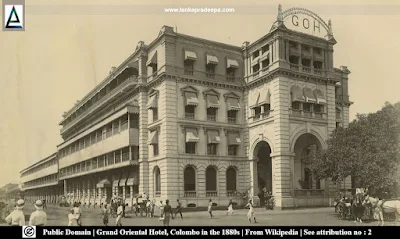
Grand Oriental Hotel (GOH) (Sinhala: කොළඹ ග්රෑන්ඩ් ඔරියන්ටල් හෝටලය) is a star-class colonial hotel situated at No. 2, York Street in Colombo Fort, Sri Lanka. It is considered to be the first modern-style hotel built in Asia (Manathunga, 2016; Rajapakshe et al., 2018; Wright, 1999).
History
The original building on the present hotel site is said to have been constructed in 1832 (Manathunga, 2016; Rajapakshe et al., 2018). It was enlarged in 1875 by Ralph Macdonald & Company following the design of James G. Smither (Manathunga, 2016; Rajapakshe et al., 2018). In 1891, a new section was added to the rear part of the building by Stevenson and Gregson firm going through the design by W. A. Tunstall, a British architect (Manathunga, 2016; Rajapakshe et al., 2018). More renovations were done to the hotel building in 1912 and 1924 (Manathunga, 2016).
In the beginning, GOH was considered one of the most modern hotels in the east comprising a lift, telephone connections, and 154 luxury rooms with electric lights and fans (Welandawe & Weerasinghe, 2016; Wright, 1999). It was the first hotel that could be easily reachable by people disembarking from the port of Colombo (Wright, 1999). In the late 19th century and the early 20th century, GOH was a popular destination among travellers and guests as it offered a view of the ocean liners lining up in the port, especially during the visits of state dignitaries and British royalty (Welandawe & Weerasinghe, 2016).
Later, GOH was taken over by the Bank Of Ceylon (BOC) who converted some parts of the hotel into their metropolitan division (Welandawe & Weerasinghe, 2016).
A protected monument
The Grand Oriental Hotel building in York Street in the Grama Niladhari Wasama Fort in the Colombo Divisional Secretary’s Division is an archaeological protected monument, declared by a government gazette notification published on 21 January 2000.
Attribution
1) SL Colombo asv2020-01 img24 Grand Oriental and SL Colombo asv2020-01 img07 GOH Chekhov suite by A.Savin are licensed under the Free Art License 1.3
2) This image (Grand Oriental Hotel, Colombo in the 1880s) has been released into the Public Domain.
References
1) Manathunga, S. B., 2016. Pauranika Sthana Saha Smaraka: Kolamba Distrikkaya (In Sinhala). Department of Archaeology (Sri Lanka). ISBN: 955-9159-39-9. pp.21-22.
2) Rajapakshe, S.; Bandara, T. M. C.; Vanninayake, R. M. B. T. A. B. (Editors), 2018. Puravidya Sthana Namavaliya: Kolamba Distrikkaya (In Sinhala). Vol. I. Department of Archaeology (Sri Lanka). ISBN: 978-955-7457-19-2. p.24.
3) The Gazette of the Democratic Socialist Republic of Sri Lanka. no: 1116. 21 January 2000.
4) Welandawe, H., Weerasinghe, J., 2016. Urban Heritage in the Western Region Megapolis Planning Project. p.31.
5) Wright, A. ed., 1999. Twentieth Century Impressions of Ceylon: Its History, People, Commerce, Industries, and Resources (first published in 1907). Asian Educational Services. pp.452-454.
Location Map
This page was last updated on 3 September 2022


